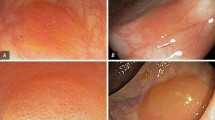Abstract
Background
We developed and evaluated the clinical usefulness of a scoring system that subclassified type Vi pit patterns.
Methods
We studied 119 colon cancer lesions (pTis, n = 26; pT1, n = 93) and 22 tubular adenoma lesions with severe atypia in which a type Vi pit pattern was visible under a stereomicroscope. Four type Vi pit pattern formation appearances (existing pits, marginal irregularities of the gland duct, narrowing of the gland duct lumen, and unclear outline of the gland duct) were defined, and the relationship between each appearance and the invasive depth of the cancer was evaluated.
Results
When the four type Vi pit pattern appearances were considered in a logistic regression analysis, the odds of a more invasive submucosal cancer were significantly increased by the appearance of marginal irregularities, a narrowed lumen, and an unclear outline. In the logistic regression analysis results, when 0.63 was used as the cutoff score for prediction of a more invasive submucosal cancer, 80 cases in the less invasive group were classified correctly (specificity, 1.0), whereas 53 (86.9%) of the 61 cases in the more invasive group were classified correctly (sensitivity, 0.869).
Conclusions
It is important first to understand the usability and limitations of objective scoring of type V pit pattern findings and then to apply this score to the determination of cancer depth in order to accurately identify lesions suitable for endoscopic treatment.
Similar content being viewed by others
References
Kudo S, Tamura S, Nakajima T, Yamano H, Kusaka H, Watanabe H. Diagnosis of colorectal tumorous lesions by magnifying endoscopy. Gastrointest Endosc 1996;44:8–14.
Togashi K, Konishi F, Ishizuka T, Sato T, Senba S, Kanazawa K. Efficacy of magnifying endoscopy in the differential diagnosis of neoplastic and non-neoplastic polyps of the large bowel. Dis Colon Rectum 1999;42:1602–1608.
Kato S, Fujii T, Koba I, Sano Y, Fu KI, Parra-Blanco A, et al. Assessment of colorectal lesions using magnifying colonoscopy and mucosal dye spraying: can significant lesions be distinguished? Endoscopy 2001;33:306–310.
Coverlizza S, Risio M, Ferrari A, Fenoglio-Preiser CM, Rossini FP. Colorectal adenomas containing invasive carcinoma. Pathologic assessment of lymph node metastatic potential. Cancer 1989;64:1937–1947.
Minamoto T, Mai M, Ogino T, Sawaguchi K, Ohta T, Fujimoto T, et al. Early invasive colorectal carcinomas metastatic to lymph node with attention to their nonpolypoid development. Am J Gastroenterol 1993;88:1035–1039.
Tsuruta O, Toyonaga A, Ikeda H, Tanikawa K, Morimatsu M. Clinicopathological study of superficial-type invasive carcinoma of the colorectum: special reference to lymph node metastasis. Int J Oncol 1997;10:1003–1008.
Sakuragi M, Togashi K, Konishi F, Koinuma K, Kawamura Y, Okada M, et al. Predictive factors for lymph node metastasis in T1 stage colorectal carcinomas. Dis Colon Rectum 2003;46:1626–1632.
Tamura S, Yokoyama Y, Ookawauchi K, Onishi T, Onishi S, Miyazaki J. Evaluation of the type V pit pattern in the lesions of colonic Tis and T1 cancer. Dig Endosc 2003;15:185–189.
Hamilton SR, Vogelstein B, Kudo S, Riboli E, Nakamura S, Hainaut P, et al. Tumours of the colon and rectum. In: Hamilton SR and Aaltonen LA, editors. World Health Organization classification of tumours, pathology and genetics of tumours of the digestive system. Lyon: IARC Press; 2000. p. 103–155.
Kudo S, Tamura S, Nakajima T, Hirota S, Asano M, Ito O, et al. Depressed type of colorectal cancer. Endoscopy 1995;27:54–57.
Kitajima K, Fujimori T, Fujii S, Takeda J, Ohkura Y, Kawamata H, et al. Correlations between lymph node metastasis and depth of submucosal invasion in submucosal invasive colorectal carcinoma: a Japanese collaborative study. J Gastroenterol 2004;39:534–543.
Tamura S, Yokoyama Y, Tadokoro T, Higashidani Y, Onishi S. Pit pattern and pathological diagnosis in the patients with colorectal tumors. Dig Endosc 2001;13(Suppl):6–7.
Kudo S, Rubio CA, Teixeira CR, Kashida H, Kogure E. Pit pattern in colorectal neoplasia: endoscopic magnifying view. Endoscopy 2001;33:367–373.
Kawano H, Tsuruta O, Ikeda H, Toyonaga A, Tanikawa K. Diagnosis of the level of depth in superficial depressed-type colorectal tumors in terms of stereomicroscopic pit patterns. Int J Oncol 1998;12:769–775.
Author information
Authors and Affiliations
Rights and permissions
About this article
Cite this article
Onishi, T., Tamura, S., Kuratani, Y. et al. Evaluation of the depth score of type V pit patterns in crypt orifices of colorectal neoplastic lesions. J Gastroenterol 43, 291–297 (2008). https://doi.org/10.1007/s00535-008-2161-1
Received:
Accepted:
Published:
Issue Date:
DOI: https://doi.org/10.1007/s00535-008-2161-1




